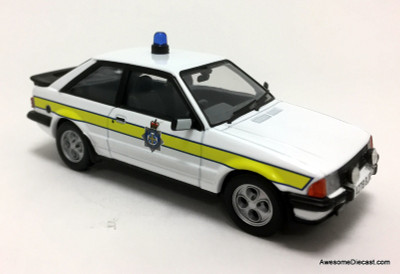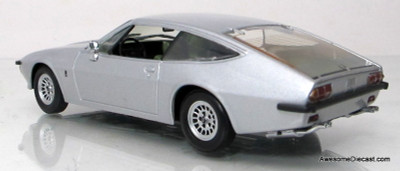Atlas
Atlas 1:43 1974 Triumph 2000: Lancashire Constabulary

Atlas 1:43 1974 Triumph 2000: Lancashire Constabulary
$61.72
The Triumph 2000 is a mid-sized, rear wheel drive automobile which was produced in Coventry by the Triumph Motor Company between 1963 and 1977. It was introduced on 15 October 1963.
Larger-engined models, known as the Triumph 2.5 PI and Triumph 2500 were also produced from 1968.
The 2000 used the six-cylinder engine first seen in the Standard Vanguard at the end of 1960. However, the last of the six cylinder Vanguards had applied a compression ratio of 8.0:1 which the increasing availability of higher octane fuels enabled the manufacturers to increase to 8.5:1 for the Triumph. This and the fitting of twin Stromberg 150 CD carburettors made for a claimed power output increased to 90 bhp (67 kW; 91 PS) from the Vanguard's 80 bhp (60 kW; 81 PS).
Standard transmission on the original car was a 4-speed manual gearbox. (overdrive and Borg-Warner Type 35 3-speed automatic transmission were options. The monocoque body had independent suspension all-round with semi-trailing arms at the rear, all using coil springs. The servo-assisted brakes were disc at the front and drums at the rear.
Although the Mk 1 was presented to the public at the London Motor Show in October 1963, volume sales began only in January 1964. Continuing in production until 1969, this version came in saloon and, from 1965, estate forms. The estate, its body shell partly built by Carbodies, was in the Mk 1 version the same length as the saloon. Various minor improvements were made during the period of which the most noteworthy, probably, was a significant upgrade in October 1966 to the "previously rather ineffective" ventilation, with eyeball vents added in the centre of the facia and the heater controls repositioned beneath them.
In October 1968 the 2.5 PI (petrol injection) Mk 1 was launched, fitted with a Lucas Automotive mechanical fuel injection system. Performance was very good, but the PI models (along with the TR6 models) gained a reputation for unreliability and poor fuel economy.
In Australia, these models suffered badly because of the summer heat. The electric fuel pump commonly overheated causing fuel to vaporise and render the engine inoperable until the pump cooled down. The overheating of the pump was caused by a combination of very high pressure fuel loads (over 110 psi (7.6 bar)) and a pump that was adapted from what was originally a windscreen wiper motor. As such, it did not cope well with sustained pressures in moderate to high ambient temperatures. Because of the launch late in the Mk I's life, there are relatively few PIs in the original shape.
In October 1969, the Mk 2 range was launched, again styled by Michelotti, updating the car for the 1970s. The front of the car now followed the lines of the then-upcoming Triumph Stag grand tourer. There were entry-level 2000 models, which were the most plentiful, but the remainder of the range consisted of 2500, 2500 TC and 2500 PI models. Apart from the PI (petrol injection) models, all Triumph 2000 and 2500s had twin Stromberg or SU carburettors, the "TC" suffix on some models can seem misleading in this respect as it stood for a higher equipment level. In June 1975 the 2500S model, with 14 inch (356 mm) wheels and anti-roll bar, was added: it replaced the 2.5PI which had quietly disappeared from the show rooms two months earlier.[12] This marked the end of fuel injected engines for the car, but improved acceleration was claimed for the twin carburettor 2500S and its slightly less expensive 2500TC sibling. These new versions featured an extensive list of other, mostly minor, improvements, of which the most significant were probably those affecting the ride and handling: these resulted from suspension changes including an anti-roll bar. The Estate in the Mk 2 version was 5 inches (125 mm) shorter than the Mk 2 Saloon, because the rear bodywork of the car was carried over unchanged from the Mk 1 version.
The Mk 2, the last big Triumph car, ceased production in 1977, supplanted by British Leyland's corporate executive car, the Rover SD1. Six-cylinder 2300 and 2600 versions of the new Rover would nonetheless be powered by engines designed by Triumph, originally intended to replace the older 2000 / 2500 units. The last production car, a 2500S estate (BOL87V) is kept at the Heritage Motor Centre.
Lancashire Constabulary is the territorial police force responsible for policing the ceremonial county of Lancashire in North West England. The force's headquarters are at Hutton, near the city of Preston. As of October 2018 the force had just under 3,000 officers as well as 2,000 Police Staff - of which 272 are police community support officers.
After many complaints over a number of years over the crime ridden state of Lancashire it was decided in 1839 that a combined county police force was required to police the county. In the same year the force was founded and Captain John Woodford was made chief constable with two assistant chief constables, 14 superintendents and 660 constables.
Over the next 50 years the police force saw many changes including the introduction of the police helmet and, during the 1860s, the force lost its first officer, PC Jump, who died after being shot by a group of men that he and a colleague were searching. By the end of the century the force had developed a detective department who were allowed to wear plain clothes. The first detective appointed was John Wallbank.
In 1917 the force first allowed female officers although it was only in the 1950s that they were allowed uniforms, and not until the 1970s were they paid at the same rate as their male counterparts. In 1948 the force's dog section was established with many differing breeds being used, but by the 1950s it was established that the German shepherd was the most suitable.
In 1965, the force had an establishment of 3,784 officers and an actual strength of 3,454, making it the second largest police force (after the Metropolitan Police) and the largest county force in Great Britain.
The force then went through major changes in the 1970s when the force was reduced to cover the new re-bordered Lancashire with the other areas coming under the jurisdiction of Greater Manchester Police and Merseyside Police.
On 10 October 2007 the Home Office announced that Lancashire Constabulary had ranked joint first, with Surrey, out of 43 forces by Her Majesty's Inspectorate of Constabularies. All 43 police forces were assessed on seven areas - tackling crime, serious crime, protecting vulnerable people, satisfaction, neighbourhood policing, local priorities and resources and efficiency.
The Radio Branch or Wireless Workshops pioneered many techniques in the use of radio by the police. In 1925 they had radio communications between constabulary headquarters in Preston and six divisional headquarters. A year later a van was equipped with a transmitter. Tests were done with radio communication to cars in the 1930s. In 1939 four fixed stations provided coverage over much of the county. At the start of World War II divisional headquarters were equipped with transmitter-receivers as a back-up to the telephone system. This was used in 1941 when the telephone system in Liverpool was put out of action by bombing, Lancashire Constabulary's radio system was sole means of communications with the city for a time. After the war they were involved in the development and move to VHF FM by the UK police. In 1961 a personal radio scheme was installed in Chorley with Motorola VHF personal radios imported from the USA after a demonstration in Stretford in 1959.
This led in 1963 to the design of the Lancon[3] VHF personal radio manufactured by GEC.














